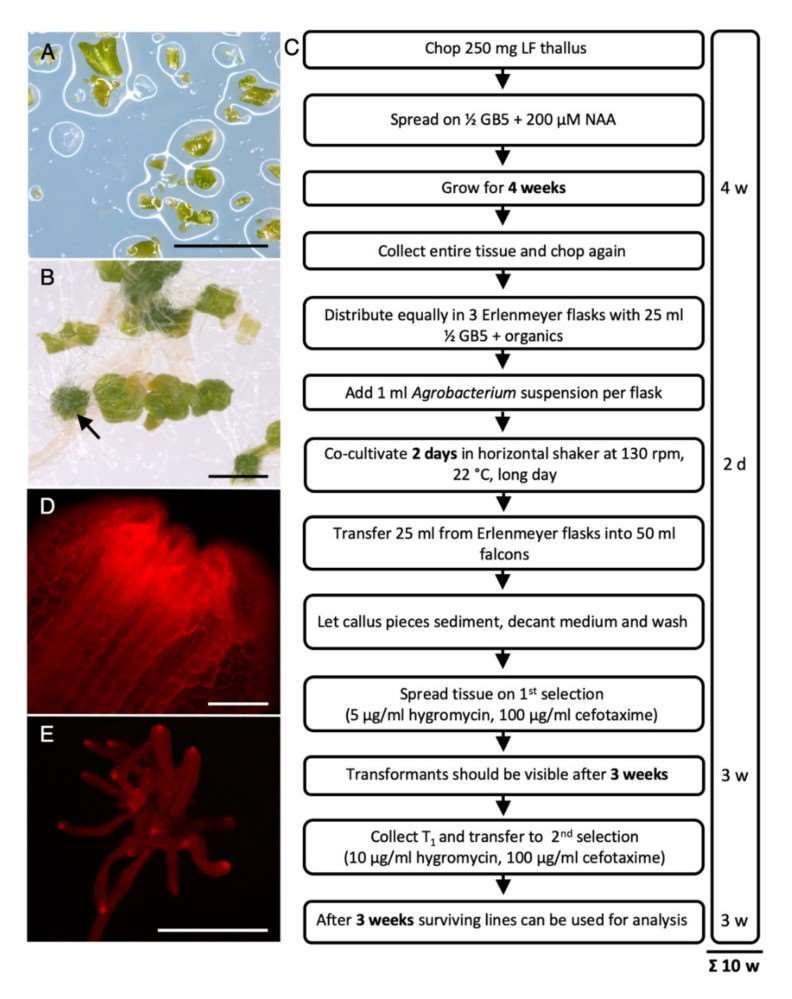Riccia fluitans (Floating Crystalwort) Transformation
The genus Riccia fluitans encompasses about 150 species and is the most diverse genus in the order Marchantiales. Riccia fluitans is a striking aquatic moss usually found in mild environments and is characterized by floating hyphae that periodically diverge into equal branches. It can also grow in terrestrial habitats with different morphological types as well as different habitats. Therefore, Riccia fluitans is an ideal model for studying the molecular mechanisms of water-to-land transition. Scientists have successfully established transformation protocols for Riccia fluitans that make it suitable for genetic analysis. Research in plant genetics and molecular biology has greatly improved our understanding of Riccia fluitans development, adaptation, and evolution.
 Fig. 1. Scheme of the R. fluitans 001TC transformation procedure. (Althoff F, et al, 2020)
Fig. 1. Scheme of the R. fluitans 001TC transformation procedure. (Althoff F, et al, 2020)
Solutions
Lifeasible is an industry leader in plant genetic transformation and is proud to offer cutting-edge genetic transformation services for Riccia fluitans. Our experts develop a robust and efficient transformation program for Riccia fluitans that allows the introduction and expression of exogenous genes in this plant species. Our protocol builds on the knowledge gained from previous studies on transformation techniques for Marchantiales and takes into account the unique characteristics of Riccia fluitans, an amphibious Marchantiales.
- Optimization of Riccia fluitans Healing Tissues
We can optimize Riccia fluitans mycorrhizal healing tissue as starting material for transformation.
- Agrobacterium-mediated Transformation
Our transformation protocol utilizes Agrobacterium-mediated transformation. Agrobacterium strains carrying the desired genetic constructs are co-cultured with Riccia fluitans healing tissues to transfer the genetic material into the plant cells. We aimed to efficiently deliver exogenous genes into Riccia fluitans and generate transgenic lines.
To ensure stable transformation, we implemented a two-step selection process using thaumatin as the selecting agent. An initial selection was performed using a concentration of 5 µg/mL, followed by a second selection using 10 µg/mL of thaumatin. These selection protocols have been optimized to improve transformation efficiency and ensure stable integration and expression of the introduced gene in Riccia fluitans.
- Characterization of Transgenic Lines
After successful transformation, we can fully characterize the generated transgenic Riccia fluitans lines, mainly by analyzing the transgene expression pattern. To ensure the stability of the transgenic lines, we can subject them to successive asexual propagation steps under selection.
Applications of Riccia fluitans Transformation
- To study the adaptation of Riccia fluitans to different environmental stresses.
- To study the genetic and molecular mechanisms underlying the adaptation of R. fluitans to different growth environments.
- Help clients understand the broader evolutionary processes that led to plant colonization on land and provide insights into the mechanisms that drive plant terrestrialization.
Lifeasible is committed to providing cutting-edge genetic transformation services for Riccia fluitans. Our optimized transformation protocols utilize Agrobacterium-mediated transformation to ensure efficient and stable gene integration and expression in Riccia fluitans. Contact us today to unlock the genetic potential of Riccia fluitans and accelerate your research on the molecular mechanisms of plant adaptation to changing environments and the transition from water to land.
Reference:
- Althoff F, Zachgo S. Transformation of Riccia fluitans, an Amphibious Liverwort Dynamically Responding to Environmental Changes. Int J Mol Sci. 2020 Jul 29;21(15):5410.
For research or industrial raw materials, not for personal medical use!
 Fig. 1. Scheme of the R. fluitans 001TC transformation procedure. (Althoff F, et al, 2020)
Fig. 1. Scheme of the R. fluitans 001TC transformation procedure. (Althoff F, et al, 2020)